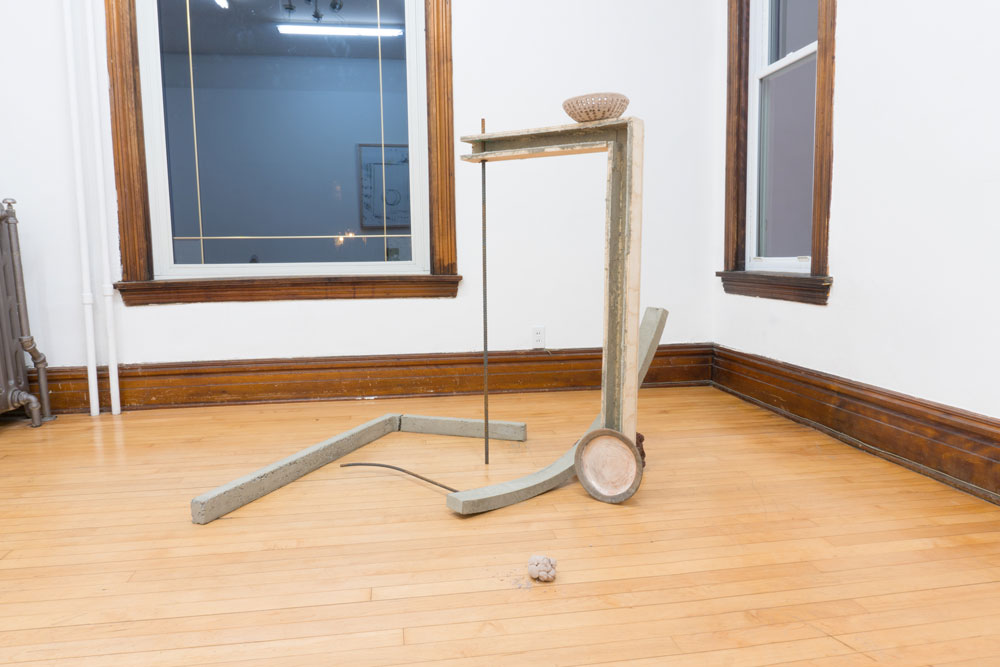Katelyn Farstad & Coral Saucedo: Yeah Maybe #27
Review by Liz Rae Heise-Glass
Yeah Maybe
Mar 24–25, 2018

Gathered. Displayed. Arranged. Inhabiting. Installed. Shown in. There are different words one could choose to describe the relationship between art objects and their surroundings when it comes to the Seward neighborhood house-gallery, Yeah Maybe. Trudging up the steps, we approach an average-looking South Minneapolis house, feeling more as if we’re heading to a house party than to a gallery opening (to which we were only vaguely, distantly invited). This sensorial confusion is not, I expect, uninvited or undesired. The three rooms spread unevenly across the first floor of the house act as vessels for the work—the domestic floors, plaster walls, wooden doors, and trims becoming participant players in the scene. Downstairs, in the basement space, musicians play throughout the evening, pumping noise up and drawing people down and then up again. This space is a living space, and lived-in space, a live space.
Inhabiting—perhaps this is the best word to describe the association between the sculptural and painted objects on view and the house that temporarily shelters them. On view for just two days, the objects are itinerant visitors here. For Yeah Maybe #27, the artworks seem to embrace their hosts in rather different ways. Some of them settle in easily, unconscious or unbothered by their own foreignness while others approach their stay more tentatively, not wanting to impose too long or disrupt too much. What emerges is something that feels like two different shows, neither of which is provided with any sort of interpretation or curatorial framing, and both of which struggle to compete with the very walls surrounding them.
The shyer of the objects are sculptural works by the LA-based artist Coral Saucedo. In the southernmost room of the house, a coven of objects (a rugged bowl, a concrete slab, a flat wooden disc, and some lumps of clay), are perched atop a cardboard shipping box, an ad hoc plinth raising it curiously off the floor. Twins of the wooden disc stand nearby, wallflowers nestling towards the room’s edge at irregular intervals. Across from them, a conglomerate of circles and lines formed of metal, plaster, and concrete has formed a soft yet seemingly impermanent arrangement where the terms propping, lying, and leaning describe a simultaneous action and inaction. Visually subdued and structurally delicate, Saucedo’s sculptures take on a tentative effect. Saucedo works with industrial materials—wood and concrete, gravel and metal, glass sheeting and ceramic tiles—her materials and arrangements easily conjuring up Home Depot and Arte Povera in equal measure. At Yeah Maybe, Saucedo’s sculptures rest like open propositions. These works seem just as happy to be refuted, rearranged, or shooed away as they seem to be as they are. Despite their rather rugged materiality, these works come across as delicate, austere, and perhaps a bit uncertain.
In the other two rooms of the house-turned-gallery, brasher, bolder guests stake a temporary claim directly on the walls, their presence more declarative than that of their floor-bound housemates. One painting, though painting alone is surely an insufficient term, confronts visitors directly as soon as they pass through the door, its muddled background giving birth to bends of foam, twists of twine, and snaking yellow ropes that stretch ardently toward the floor. The other objects gather in a third room, the walls of which have been painted an uneven, vigorous yellow.
While Saucedo’s objects seem self-contained, these collage paintings by Minneapolis’ Katelyn Farstad are unselfconscious. They are shape-shifting, uncomfortable creatures that explode from their canvas supports. Colorful spews of tentacles, splashes of shells, and swarms of letters extend from the frame and encroach into the space. Though all layered, multi-part, and complex, all five of the works gathered here seem to be speaking in different registers, talking to one another but perhaps not finding themselves understood. These are slightly manic objects, clasping erratically, energetically to the walls and doors of the room. These objects are both light and dark at once, charging both liveliness and melancholy into and from their vibrant yellow berth.
Perhaps it is partially the nature of the space that invites these works to be read so anthropomorphically. Domestic in scale and in use, Yeah Maybe offers an unusual context for the objects it fleetingly holds. The artworks inhabiting Yeah Maybe are inserted into an unfolding social narrative and a familiar domestic architecture—a context in which they may become either characters or scenery. While the peculiarities of seeing and staging art in this alternative space are compelling in some ways, the lack of contextualization, interpretation, or curatorial framing apparent in the space of the exhibition makes for a diminished experience. The forced cohabitation of the space could offer an opportunity for a conversation between and among objects and the artists who create them. From what I was able to witness, however, there was no attempt to integrate the works of these two artists, or to provide a rationale for the exhibition overall. Each of these artists’ works emerged with personalities and peculiarities of their own, but their voices were just a little hard to hear over the din of the space.
